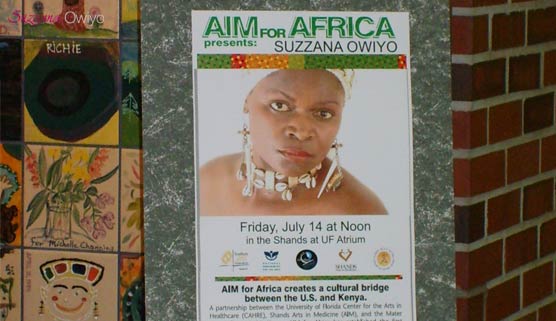The Mater Hospital in Nairobi has Introduced the first programme of its kind in Africa Aimed at Fostering patient’s holistic healing through music by involving the body and spirit , writes LILLIAN ALUANGA
Pains and aches are momentarily forgotten as some patients nod their heads and tap their feet in tune to the songbirds catchy dholuo lyrics. Others, perhaps surprised but excited to see the tall belle strumming her guitar at a hospital lounge, simply stare.
As the song comes to an end, Owiyo throws a dimpled smile at her appreciative audience, excuses herself and swiftly makes her way to the hospital’s Lourdel ward, where she is scheduled for another performance. This time, for the in-patients.
Barely 10 minutes later, Owiyo is at it again, belting out another popular hit, much to the delight of a group of nurses and patients gathered at one end of a long corridor.
“Please play Malaika,” pipes one of the patients, a middle aged woman with short cropped hair, donning a green hospital gown. Owiyo obliges and the woman’s face breaks into a smile as the songbird croons….
Malaika nakupenda malaika
Nami nifanyej4 kijana mwenzio...
A nurse standing in the group reaches to the woman and gently takes her hand. The pair then slowly waltzes around the `miniature ballroom’ formed by the circle of hospital staff and patients.
This scene is just one of several that now characterise operations at Mater in the institution’s quest to embrace an ‘Arts in Medicine Programme’. The programme, which comes at no additional cost to patients, is the first of its kind on the continent and is aimed at fostering an individual’s holistic healing by involving both body and spirit.
The concept, though used successfully by dozens of hospitals in the West, is new to Africa and has Mater, working in partnership with the Centre for the Arts in Healthcare Research and Education at the University of Florida, as the pioneer institution of such a programme.
A medley of golden oldies popularly known as ‘Zilizopendwa’ wafts down the hospital’s corridor as Owiyo sings her heart out. The familiar tunes draw the attention of several patients curiously peeking at the group from the wards. Some opt to move closer.
A middle-aged man is wheeled out onto the corridor by one of the hospital’s orderlies and promptly handed a triangle by one of the nurses. It only takes him a few minutes to get settled as he picks up the rhythm….
“Kola kolola, mama kolola kolola,
Embe dodo embe dodo
Limelala mchangani
The man begins to hum along to the song and smiles as the group breaks into a popular chorus.
Tembea na Yes … Amen
Tern bee na Yesu ndugu….
Amen, halleluyia Amen
“I have never seen anything like this before, but I am happy that I chose to leave the ward and come here,” says the male patient, Mr Titus Wandaki.
“This makes me forget my pain for a while. It makes me feel like part of the world again and reminds me that I am not alone,” he says, as he slowly adjusts his neck brace.
Wandaki recalls how he first heard of the programme from nurses doing their rounds in the ward and decided to have a first hand experience. So far, he has not been disappointed by its activities.
“When I come out here and join in the singing, my loneliness disappears and I stop feeling sorry for myself,” Wandaki says. He, like several other patients seated in the midst of the group, appear subdued at the start of the session, but gradually warms up to the activities, egged on by the soft singing and cheery faces of the nurses who form part of the team.
As the jingle of a tambourine and clang of a triangle fills the air, the erstwhile taut muscles on the patients’ faces begin to relax, their eyes brighten and their aching bodies slowly begin to move; a shaking of the head here, a snapping of the finger there, and the tapping of feet, slowly begin to inject life into the patient’s faces.
Laughter comes in large doses too as some of the patients shyly take the hands of the volunteers, mainly nurses at the hospital, and join them in a dance.
The nurses apparel is equally cheerful with tiny multi coloured raffia crowns perched on their heads. Their aprons, though white, bear a rich mix of embroidery and other hand woven patterns. The musical instruments are simple. Save for a tambourine, guitar and triangle, the group largely depends on their melodious voices and beaming faces to work the magic of healing.
“When we first went to the women’s ward we were told that none of them could move out of their beds but look at them now,” says an excited Winnie Ojve-Njenga, the programme’s co-ordinator. patients here,” Njenga says.
Owiyo, who first heard about the project last year, says getting involved with such projects is one avenue through which people can give back to the society.
It is one way of sharing your time with people who have less access to the arts because of their conditions,” she says.

